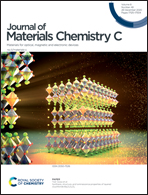The importance of the molecular weight of PEDOT hole transporting materials for efficient organic solar cells†
Abstract
Poly(3,4-ethylenedioxythiophene) (PEDOT) conducting polymers have been extensively studied as hole transporting materials (HTMs) in organic electronic devices. However, almost none of the reports have revealed the molecular weight effect of PEDOT on the device performance. Herein, analysis of the molecular weight effect is enabled using a polymerization strategy on a representative model system of poly(styrenesulfonate) doped PEDOT (PEDOT:PSS) which produces conducting polymers with tunable PEDOT molecular weights. Experiments reveal that the power conversion efficiency (PCE) of PBDB-T:ITIC organic solar cells fabricated using these PEDOT:PSS HTMs first increases from nearly 0 to 1.32 and to 9.91% with increasing PEDOT molecular weight. This is primarily due to the enhancement of the doping degree of PEDOT and the phase seperation between PEDOT and PSS that produces enormous shifts in HTM conductivity from nearly insulating (7.70 × 10−7 S cm−1) to medially conductive (1.14 × 10−4 S cm−1) and to highly conductive (7.22 × 10−4 S cm−1). With the further increase of PEDOT molecular weight, the PCE rapidly reaches up to 10.36% and stays unchanged, which seems to be largely determined by the combined effect of enhanced conductivity and increased roughness of HTMs that produces an optimal balance between the hole collection and carrier recombination loss in devices. These findings highlight the importance of optimizing PEDOT molecular weight for PEDOT-based HTMs to help realize the full potential of organic optoelectronic devices.



 Please wait while we load your content...
Please wait while we load your content...